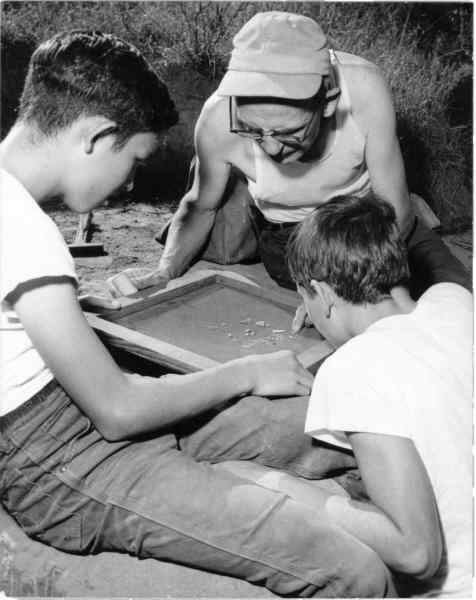|
Measurements and Comparison
How does the paleontologist find out if a fossil is or is not a
previously unknown species? He compares it with specimens that have already been
identified. The comparisons are quite precise. They are based on measurements,
in millimeter. Often differences in size between parts of specimens being
compared are so slight and critical that fractions of millimeter must be used.
This discussion should give you some idea of how such measurements are taken and
recorded and how conclusions are drawn from recorded data.
|

|
| Wes Gordon looking for fossils with students
from local schools. |
During the time that studies were
proceeding on the jaw identified by Savage, another coyote jaw with teeth was
found at site T2 by a party of diggers from the university. Did these two jaws
belong to the same species whatever that was? Measurements of both jaws were
taken and compared. Below shows the
measurements as they appear in the doctorial thesis Savage wrote.
|
Comparative Measurements of
the Teeth in Two Coyote Jawbones |
| Distance, P2
to M2
inclusive |
70.6 |
66.2 |
| Anteroposterior
diameter^,
P2 |
11.6 |
10.4 |
| Transverse diameter_,
P2 |
5.1 |
4.9 |
| Anteroposterior
diameter, P3 |
12.1 |
11.5 |
| Transverse
diameter, P3 |
5.1 |
5.1 |
| Anteroposterior
diameter, P4 |
13.8 |
13.1 |
| Transverse
diameter, P4 |
6.6 |
6.4 |
| Anteroposterior
diameter, M1 |
23.9 |
21.5 |
| Transverse
diameter, M1 |
10.2 |
8.7 |
| Anteroposterior
diameter, M2 |
10.0 |
9.6 |
| Transverse
diameter, M2 |
7.6 |
7.0 |
^
Distance across the tooth, front to back.
_ Distance across
the tooth, from side to side.
*The single specimen to which
others are compared for identification. Usually the identify
of this specimen is known. In this case, however, both were
unknown, and it was Savage's choice as to which would be listed as
the holotype. He chose the specimen discovered first. (Previous
page) |
|